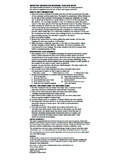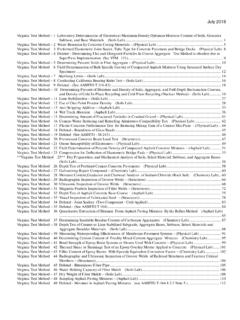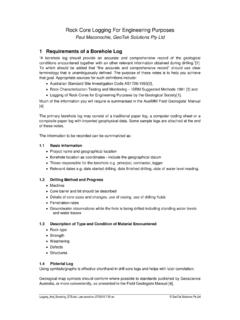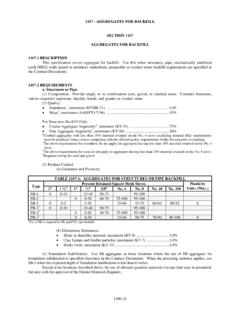Transcription of FOR USE IN SOIL ONLY. DO NOT USE IN LIQUIDS.
1 FOR USE IN soil ONLY. DO NOT USE IN LIQUIDS. IMPORTANT INFORMATION REGARDING YOUR NEW METER. These instructions cover all aspects related to the analyzer's function and will help guide you to experiencing the proper temperature, pH and fertility range for the plants you intend to grow. BEFORE TESTING THE soil . If you are preparing to plant a bed of plants or shrubs, or to plant a crop of fruits and vegetables, or to put out grass seed, you will find it beneficial to sample and test the soil in a number of locations in the area to confirm that the soil is warm enough for what you want to plant, that the soil s pH is generally consistent over the entire area and that it is within the plant s pH range.
2 BASIC OPERATING INSTRUCTIONS. 1. Press the power button to turn the meter on and off. 2. When the meter is turned on for the first time it defaults to fertility. Toggle Switch 3. After using for the first time, the meter will default to the function last used. 4. The toggle switch is located on the right side of the meter. Hold Button 5. Move the toggle switch up or down to change test function. 6. The test function in use is indicated by the blinking arrow on the meter face. 7. When not in active use, the meter will turn off after about four (4) minutes, to preserve battery life.
3 HOW TO USE YOUR METER TO MEASURE soil TEMPERATURE. 1. With the unit turned on, and in temperature mode, insert the probe to a minimum depth of 2 to 3 (5-8 cm) into the soil . 2. Wait 60 seconds to acclimatize the probe and note the LCD reading. Remove the probe from the soil . soil Temperature Ranges Vegetable Will Germinate Ideal Germination Transplanting Seedlings Out Asparagus 50F - 90F 70F. Beans 60F - 90F 80F. Beets 40F - 90F 80F. Broccoli 40F - 90F 80F 50F. Cabbage 40F - 90F 80F 45F. Cantaloupe 60F - 100F 90F 65F. Carrot 40F - 90F 80F. Cauliflower 40F - 90F 80F.
4 Celery 40F - 80F 70F 45F. Chard 40F - 90F 80F. Corn 50F - 100F 80F 60F. Cucumber 60F - 100F 90F 65F. Endive 40F - 75F 75F. Lettuce 40F - 75F 75F. Okra 60F - 100F 90F 70F. Onion 40F - 100F 90F 45F. Parsley 40F - 90F 80F. Parsnip 40F - 90F 70F. Peas 40F - 80F 70F 45F. Pepper 60F - 90F 80F 65F. Pumpkin 60F - 100F 90F 65F. Radish 40F - 90F 80F. Spinach 40F - 80F 75F. Squash 60F - 100F 90F 65F. Tomato 50F - 100F 80F 60F. Watermelon 60F - 110F 90F 65F. HOW TO USE YOUR METER TO MEASURE pH. 1. Remove the top 2 of the surface soil . Break up & crumble the soil underneath to a depth of 5.
5 Remove any stones or organic debris such as leaves and twigs because they can affect the final result. 2. Thoroughly wet the soil with water (ideally rain or distilled water) to a mud consistency. 3. Use the toggle switch to move the indicator arrow to point to pH. 1. 4. Using the supplied pad, lightly shine 3 - 4 (7 - 10 cm) of the probe, carefully avoiding the bullet shaped tip, to remove any oxides that may have formed on the surface of the metal. Wipe the probe clean using a cotton ball or tissue. Always wipe away from the probe tip, toward the probe handle.
6 5. Use the toggle switch to move the indicator arrow to point to pH. 6. Take the initial reading: Push the probe directly into the moistened soil to a depth of 2 -3 . If it does not slip into the ground fairly easily, select a new position. Never force the probe. Twist the probe clockwise and counter-clockwise between your fingers several times to ensure that damp soil is well distributed over the surface of the probe. Wait for 60 seconds for the probe to acclimatize and note the LCD reading. Remove the probe from the soil . 7. Based on the results of the initial reading, take the final reading: a.
7 If the initial reading is pH 7 or higher, wipe any soil particles from the surface of the probe. Re-shine the probe and insert back into the soil at a different point, avoiding the first hole made by the probe. Twist the probe two or three times between the fingers, as before, and wait 30 seconds before taking the final reading. b. If the initial reading is below pH 7, wipe any soil particles from the surface of the probe. Do not re-shine the probe. Insert the probe back into the soil at a different point, avoiding the first hole made by the probe.
8 Twist the probe two or three times between the fingers, as before, and wait 60 seconds before taking the final reading. In order to obtain an even more accurate result when measuring soil pH with your unit, the following procedure may be adopted. Take the sample of soil to be tested from the ground and remove stones and organic debris. Prepare the sample by crumbling the soil into small particles. Measure two cups of soil from the prepared sample. Fill a clean glass or plastic container with two cups of distilled or de-ionized water and add the measured soil sample.
9 Ensure the soil and water is thoroughly mixed and compact the sample firmly. Drain off any excess water. Proceed to step 3 of How to Use Your Meter to Measure pH. ADDING LIME TO INCREASE pH. Lime can be added at any time of year but it does need time to take effect which is why the autumn, winter and early spring are the preferred times. The two main types of lime are ground limestone and hydrated lime. Ground limestone is slower acting but more pleasant to handle. Hydrated lime may take effect in two or three months but ground chalk or limestone may take up to six months.
10 The amount of lime needed to raise a spade s depth of top soil by 1 pH varies from oz. of hydrated lime or oz. ground limestone on sandy soil to 11 oz. of hydrated lime or 15 oz. ground limestone on heavy clays or peaty soils per square yard. So do not expect pH correction to be too precise! Avoid adding lime at the same time as sulfate of ammonia, superphosphate, basic slag or animal manures. Lime may be used in combination with sulfate of potash or muriate of potash. It is because of the natural drop in pH that there is such an emphasis on adding lime.












